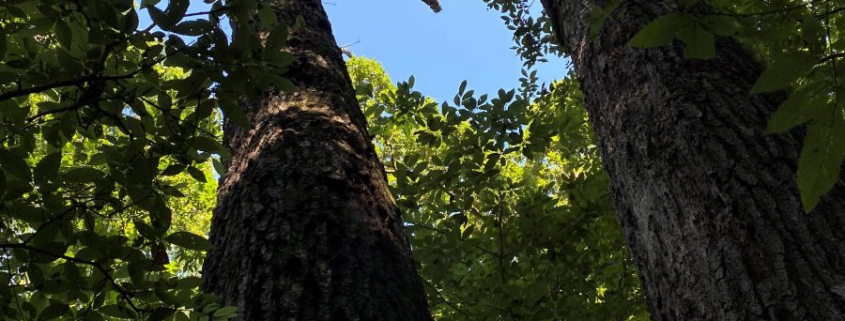An Aging Tennessee River Riparian Forest
August 8, 2020 I bushwhacked (Webster definition: to travel by foot through uncleared terrain) through a Tennessee River riparian forest on the eastern end of Wheeler National Wildlife Refuge north of the river in Limestone County Alabama. I restricted my wanderings to off-trail, insisting that my ramblings keep me within the closed-canopy forest. I wanted to experience, feel, sense, and see the forest intimately. I had previously passed along the forest’s northern edge on a gravel access road by bicycle and on foot. I have often mused that I prefer hiking alone or with another naturalist who is content with (more accurately, demands) walking in the woods… not racing through the forest. Just as is true with life and living, it is the journey and not the destination that rewards!
I wandered off-trail nearby just a week earlier, issuing a Post of my general observations and reflections: https://stevejonesgbh.com/2020/08/19/august-riparian-forest-roaming-at-the-wheeler-national-wildlife-refuge/ This subsequent Post focuses on the transition this forest is making from vibrant mature to old growth.
A Vibrant Forest with Healthy Trees
The Corps of Engineers completed Wheeler Dam November 9, 1936. TVA had begun purchasing lands destined for impoundment and as a buffer in 1934, including this forestland. As was often the case along the necklace of TVA dams and lakes, either timber harvesting or agricultural abandonment occurred on the buffer acreage. Because the forest I hiked evidenced numerous old windthrow mounds (from a forest predating 1934) I concluded that this land had not been cleared and cultivated. Instead, I believe the prior forest had been cutover in the mid-1930s, naturally regenerated to mixed hardwoods, predominantly oak with hickory, poplar, and sweetgum, and a scattering of loblolly pine. The forest has flourished on these rich lowland sites for the past 85 years or so. I have biked along nearby stands dominated by pine. I will devote a future wandering hike to exploring that stand, which I believe will prove to be established on abandoned farmland, perhaps even planted to pine.
Many of the dominant canopy trees (below) reach 100-feet and higher. I characterize the forest as mature… transitioning toward a state I’ll call old growth: big trees, lots of dead and down woody debris, and some other large trees showing signs of decline and death, with sporadic canopy openings (from blowdowns and standing tree demise) regenerating and filling in from below and from adjacent main canopy trees reaching into the openings. The two photos below depict the conditions typical across the acreage I walked. Beautiful sylvan conditions that big-tree lovers like me admire and adore. Oak (Quercus sp.) has some traits offering hints about stand origin. I surmise that the cutting in the mid-1930s removed the higher quality oaks then present, leaving unmerchantable saplings and poles, including some damaged by the logging. Oak regenerates often from stump sprouting after cutting. I am confident that seedling regeneration accounted for few stems in today’s forest. I will offer explanation as we proceed through the photo-essay below.
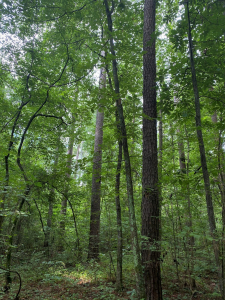
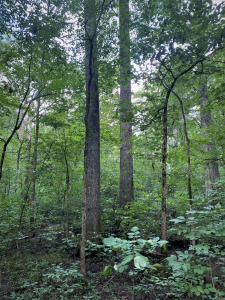
Because this riparian site is fertile and moisture plentiful, these oaks (above) grow tall, beautifully negatively geotropic. Likewise for the yellow poplar (Liriodendron tulipifera) below. From the Google online dictionary: geotropism is the growth of the parts of plants with respect to the force of gravity. The upward growth of plant shoots is an instance of negative geotropism. No question about where gravity pulls these tall straight stems. The old industrial forester in me still appreciates those clear logs, blemish-free, reaching toward a canopy high above.
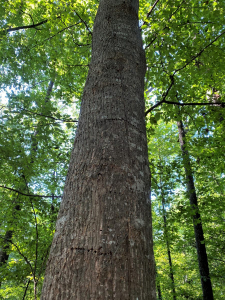
This black oak (Quercus velutina) also reaches for the sky, rising from a stout trunk.
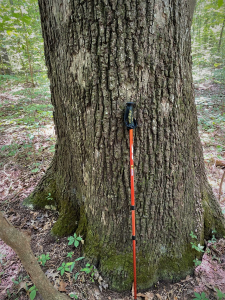
Oaks, poplar, shagbark hickory (Carya ovata; below), and sweetgum (Liquidambar styraciflua; not pictured) dominate the stand.
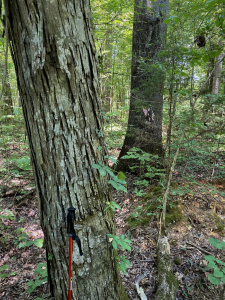
The trees I included above are healthy, full-crowned, and show no signs of disease or decline. They suggest to the uninitiated a forest that has flourished for centuries, that will likely persist for many more, unchanging and static. I’ve queried forest landowners in Pennsylvania (where I conducted workshops during the 12 years I served on the faculty at Penn State University (1987-96)) about the age of various forests where we stood. At the time, most of the state’s forests had been cut clean 70-90 years prior. Respondents commonly guessed that the forests ranged between hundreds of years to “since the time of Christ.” I am certain that were I to ask about the age of the Wheeler NWR riparian forest, the answers would have fallen within the same range. We 21st Century northern Alabama citizens, like lay citizens everywhere, are sadly uninitiated about about Nature. Our ignorance extends to Alabama’s 23.1 million acres of forestland, home to what the US Forest Service Southern Research Station in 2016 estimated as 16.98 billion trees. Although our southern forest trees will outlive most of us, they, too, have finite lives. In fact, I saw unmistakable signs of decline as I meandered through the forest.
And Some Not So Healthy
Not all individuals stood strong and carefree. This white oak (Quercus alba) looked sound, yet a large bracket fungus mushroom (a resinous polypore) sprouted from its base, suggesting that dead wood is within reach. I could not discern with certainty whether the dead wood is of the oak, or just nearby. I viewed it as a signal (an indicator) of potential trouble, not as a definite sign of ailment. Were I, as I did decades prior, still purchasing standing timber for a hardwood sawmill in Waverly, Virginia, I would be skeptical that this individual had interior rot, significantly degrading log quality and value.
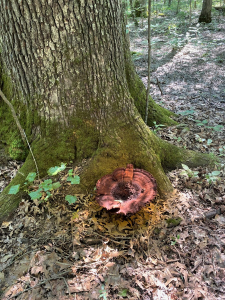
Other trees evidenced signs (not just symptoms) of certain degradation and reduced vigor, vitality, and value. This 30-inch diameter oak still has a vibrant crown, yet is clearly hollow, likely home to critters of various sorts. Fungal fruiting bodies (to the right of the trekking pole below right) evidence dead wood along a vertical seam. I pondered why this large diameter oak appears to be long-hollowed. My forensic forestry yielded an answer. This oak is a residual from the mid 1930s logging, perhaps too small to harvest, damaged by that operation, and left to populate the new forest. The scarred trunk served as an infection court for decay fungi. It has lived with the decay for nine decades, inconvenienced but not fatally limited. As a surviving remnant in the new stand, it likely stood 30-40 feet above the regenerating stems, and had advantageous access to sunlight as well as soil nutrient and moisture resources. I have no idea how many more years it will withstand the stresses of decay, wind, ice, and gravity.
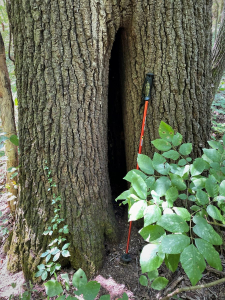
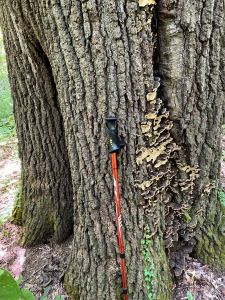
The burled-base black oak (below left) does not just suggest heart rot… it proclaims it with full throat. As does the black oak (below left) with direct external access to its hollowed interior. Like the 30-inch tree above, these two black oaks are probably original stand remnants injured 80-90 years ago and extending life into this new forest.
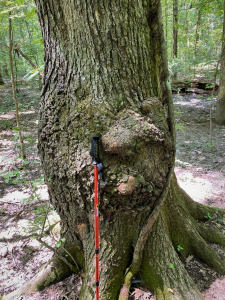
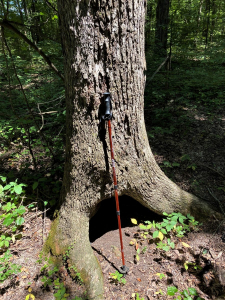
These are the walking wounded, spanning a forest generation, bridging a 19th-century forest into the 21st. I can’t imagine them lasting into the 22nd. The force and facts of Nature argue to the contrary. Their time will come within the remaining 80 years of this century.
And Some in Various Stages of Standing Dead
Others no longer walk, yet remain standing, awaiting that threshold of physics when strength no longer exceeds the force of gravity. The twin-oak below has not yet completely shed its bark, suggesting that its death knell sounded no longer than five years ago. I found no obvious cause of death. However, I know that usually some precipitating factor triggers demise. Perhaps I missed seeing a lightning scar, or evidence of deep decay. Or a disease of some sort. I suppose we could conclude that it died of natural causes. This twin had mastered its neighborhood, reaching high, spreading wide, and flourishing. We’ve all lost friends who flourished until an untimely and unexpected illness (or accident) took them.
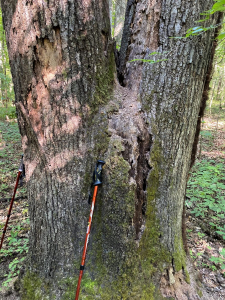
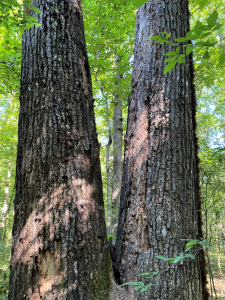
Here’s the vertical view from the double-tree’s base. Its crown has lost all small branches, leaving only a coarse skeleton, indicating to me that death arrived on the far end of no longer than five years ago. Already, its neighbors are filling in the canopy-opening. Nature really does abhor a vacuum!
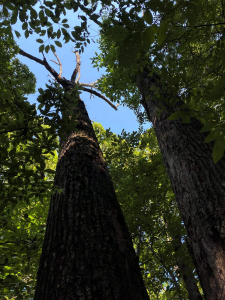
Yet another oak is under full fungal attack, its lower three feet of trunk decorated by hundreds of fruiting bodies. The view skyward reveals another crown already having shed all small twigs and branches. And like the large twin oak, its canopy opening is rapidly filling.
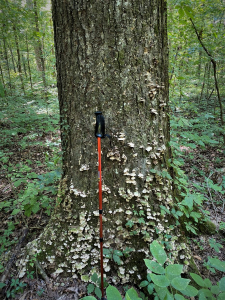
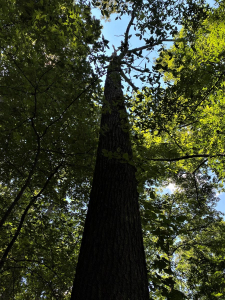
Others among the standing dead are mere snags. Both of these below lost their tops at 20-30 feet above the ground. The hollow and well-rotted snag below left will slump, tip, or slip to horizontal before too many more Earth orbits. The other, an oak (below right), retains some bark, and likely died more recently, and may persist in the vertical a few years longer. It’s another 30-inch diameter remnant from the 1930s logged stand.
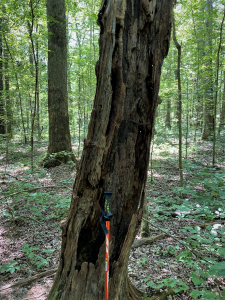
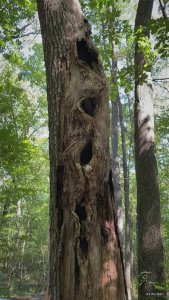
The US Forest Service published a definition of old growth forest in 1989, paraphrased here: Old growth forests are ecosystems distinguished by large old trees (living and dead) and related structural attributes…that may include tree size, accumulations of large dead and down woody material, multiple canopy layers, species composition, and ecosystem function. Most scientists would now include vertical and horizontal diversity in tree canopy as an important attribute. To this point I’ve described the standing elements of this aging riparian hardwood forest.
And Others Dead and Down in Various Stages of Decay
This stand also meets the dead and down woody debris criterion. As with many other stems described above, the poplar (below left) and oak (below right) had stood hollowed for decades, with the pace of decay and growth in equilibrium until the physics of strength and stress brought them to the ground. With every instance of main canopy stem attrition the forest shifts toward meeting the old growth definition. Openings encourage a layered sub-canopy and a forest patchwork of tree ages and species composition. Nothing is static in our forests.
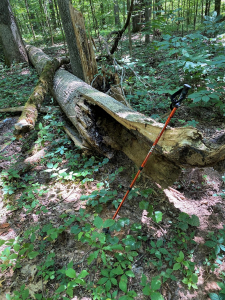
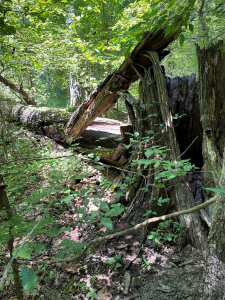
Trunks failed on both the poplar and oak above. The physics of relative stem strength, root anchorage, and wind torque determine whether a crown topples earthward, the trunk fractures along its lower length (above), or the roots and soil mass lift 90-degrees as below. In whatever way the threshold is surpassed, gravity ensures the final pivot to the forest floor. Oh, what a wonder to behold, were I given assurance of no personal harm, to experience the visual fury, concussive noise and wind blast, shattering vibrations, and even the fresh-fractured fragrance of wood and heaving soil. If a tree falls in the forest and no human is there to witness, will it make a sound? I am not a student of metaphysics, therefore I will not (now or ever) argue the question and its answer. Instead, I believe that physics does not give a rip whether a person is nearby or not. The catastrophic forces at play when the massive oak trembled, yielded, and toppled are evident. The ground heaved, the trunk shook the earth, crushing nearby stems to the ground, the whipping and falling crown fanned powerful gusts, and the noise would have been audible for half-a-mile, even if no person stood within its reach. Will such a falling tree make a sound if no one is present? Damn right!
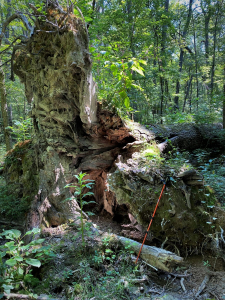
Bark still held to the big tree above, suggesting it had fallen within the past five years. More time has passed for the fallen two-foot diameter victim below. Let’s consider my estimates courtesy of forensic observation. The transformation from standing vigorous main canopy occupant to prostrate decaying log to forest floor duff occurs predictably within a given location, varying with climate, the factors that killed and brought the tree to horizontal, and species. I don’t claim to be an expert, however, I am learning through disciplined observation.
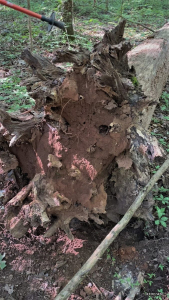
Death, decay, and recycling to the soil is a process as certain as taxes, and far more practiced through time. Nature exacts a price on all living organisms. Nature demands a death tax, her way of assuring that life continues forevermore… so long as Earth remains in our sun’s inhabitable zone. The carbon cycle of life and death will persist, with or without the presence of humans. And trees will fall whether anyone will ever hear them again.
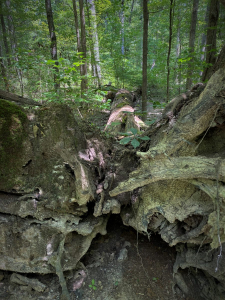
A secondary tree-death tax comes in the form of releasing sunlight to successors. The former main canopy tree, represented by the broken snag (below left) fought many decades to achieve its full access to its sunlight-fuel, igniting chloroplasts that year after year added new wood, incremented vertical and horizontal shoot growth, and committed roots to exploiting soil nutrients and moisture. Death liberates the precious sunlight to the ever-changing forest, including the next generation and beyond. The dead and down woody debris refreshes and enriches the essential soil.
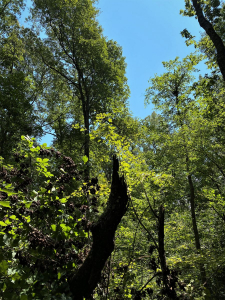
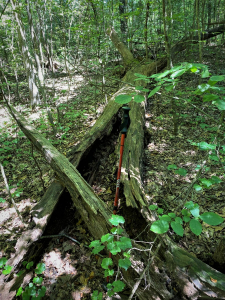
Forest forensics traces the carbon recycling from majestic tree to soil organic matter.
Deeply Decayed — Nearly Fully Recycled, Beginning the Cycle Anew
This stump is still upright, but its days are numbered. I found no trace of the trunk and branches that toppled near the stump decades ago. Let’s view this stump as a monument… for the moment. Its only lasting legacy is the forest that succeeds it and the nearby trees tapping the rich forest soil.
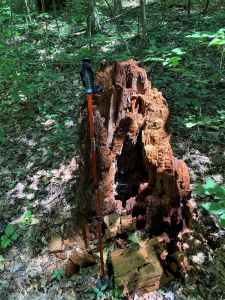
As I develop my formal Land Legacy Stories (a consulting product I offer through my Great Blue Heron, LLC), I always recommend that the property owner install permanent photo points, returning every 5-10 years to chronicle long term change. Imagine if one had been established near the two locations below back in the 1930s. We would be able to track the life, death, and decay of the trees that are now nearly fully soil-incorporated.
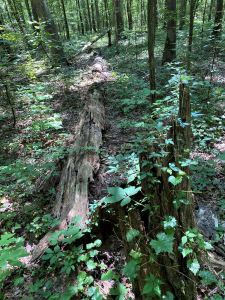
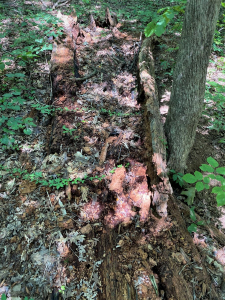
Yet, as nice as the photo record would be, my forest forensic services would be of little value. I enjoy hiking within the forest, this one or any of hundreds that I’ve explored over the nearly five decades that I’ve practiced forestry, and reflecting upon Nature-Inspired Life and Living.
Thoughts and Reflections
I draw two lessons from exploring this aging riparian forest on the Wheeler National Wildlife Refuge:
- Every forest tells a compelling story, one rich with Life and Death
- And every story accents my appreciation for Nature-Inspired Life and Living
-
Inhale and absorb Nature’s elixir. May Nature Inspire, Inform, and Reward you!
Note: All blog post images created & photographed by Stephen B. Jones unless otherwise noted. Please circulate images with photo credit: “©2020 Steve Jones, Great Blue Heron LLC. All Rights Reserved.”
Another Note: If you came to this post via a Facebook posting or by an another route, please sign up now (no cost… no obligation) to receive my Blog Post email alerts: http://eepurl.com/cKLJdL
And a Third: I am available for Nature-Inspired Speaking, Writing, and Consulting — contact me at steve.jones.0524@gmail.com
Reminder of my Personal and Professional Purpose, Passion, and Cause
If only more of us viewed our precious environment through the filters I employ. If only my mission and vision could be multiplied untold orders of magnitude:
Mission: Employ writing and speaking to educate, inspire, and enable readers and listeners to understand, appreciate, and enjoy Nature… and accept and practice Earth Stewardship.
Vision:
- People of all ages will pay greater attention to and engage more regularly with Nature… and will accept and practice informed and responsible Earth Stewardship.
- They will see their relationship to our natural world with new eyes… and will understand more clearly their Earth home.
Tagline/Motto: Steve (Great Blue Heron) encourages and seeks a better tomorrow through Nature-Inspired Living!
Steve’s Three Books
I wrote my books Nature Based Leadership (2016), Nature-Inspired Learning and Leading (2017), and Weaned Seals and Snowy Summits: Stories of Passion for Place and Everyday Nature (2019; co-authored with Dr. Jennifer Wilhoit) to encourage all citizens to recognize and appreciate that every lesson for living, learning, serving, and leading is either written indelibly in or is powerfully inspired by Nature.
I began writing books and Posts for several reasons:
- I love hiking and exploring in Nature
- I see images I want to (and do) capture with my trusty iPhone camera
- I enjoy explaining those images — an educator at heart
- I don’t play golf!
- I actually do love writing — it’s the hobby I never needed when my career consumed me
- Judy suggested my writing is in large measure my legacy to our two kids, our five grand kids, and all the unborn generations beyond
- And finally, perhaps my books and Blogs could reach beyond family and touch a few other lives… sow some seeds for the future

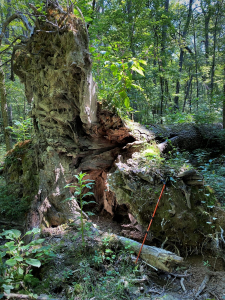
All three of my books (Nature Based Leadership; Nature-Inspired Learning and Leading; Weaned Seals and Snowy Summits) present compilations of personal experiences expressing my (and co-author Dr. Wilhoit for Weaned Seals and Snowy Summits) deep passion for Nature. All three books offer observations and reflections on my relationship to the natural world… and the broader implications for society. Order any and all from your local indie bookstore, or find them on IndieBound or other online sources such as Amazon and LifeRich.

